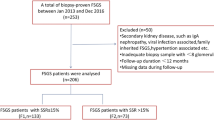Abstract
The goal of this study was to estimate the diagnostic and prognostic accuracy of renal biopsies in focal segmental glomerulosclerosis (FSGS), accounting for the focal nature of affected glomeruli. Computational simulations were performed on a total of 138,600 virtual kidneys, across a range of FSGS involvement. Simulations were designed to address the diagnostic accuracy of renal biopsies, and the biopsy characteristics required to reflect accurately the true degree of involvement of FSGS in the entire kidney or just the juxtamedullary (JM) region. The diagnostic accuracy of renal biopsies for the detection of at least one FSGS glomerulus exceeded 80% when 10–20% of the kidney was affected by FSGS. Hundreds to thousands of biopsy glomeruli were required to characterize reliably the true extent of FSGS when fewer than 75% of the kidney’s glomeruli were affected. Renal biopsies with an average of 20 glomeruli did not accurately reflect the extent of FSGS in kidneys until at least 80% of all glomeruli in the kidney were affected. Targeting JM glomeruli did not result in significant improvements in the prognostic performance characteristics of renal biopsies. These findings suggest that conventional renal biopsies might be inadequate for characterizing the extent of FSGS.



Similar content being viewed by others
References
Benfield MR, McDonald RA, Bartosh S, Ho PL, Harmon W (2003) Changing trends in pediatric transplantation: 2001 Annual Report of the North American Pediatric Renal Transplant Cooperative Study. Pediatr Transplant 7:321–335
Baum MA, Stablein DM, Panzarino VM, Tejani A, Harmon WE, Alexander SR (2001) Loss of living donor renal allograft survival advantage in children with focal segmental glomerulosclerosis. Kidney Int 59:328–333
Baum MA, Ho M, Stablein D, Alexander SR (2002) Outcome of renal transplantation in adolescents with focal segmental glomerulosclerosis. Pediatr Transplant 6:488–492
Jungraithmayr TC, Bulla M, Dippell J, Greiner C, Griebel M, Leichter HE, Plank C, Tonshoff B, Weber LT, Zimmerhackl LB (2005) Primary focal segmental glomerulosclerosis—long-term outcome after pediatric renal transplantation. Pediatr Transplant 9:226–231
Morita M, White RH, Coad NA, Raafat F (1990) The clinical significance of the glomerular location of segmental lesions in focal segmental glomerulosclerosis. Clin Nephrol 33:211–219
Fogo A, Glick AD, Horn SL, Horn RG (1995) Is focal segmental glomerulosclerosis really focal? Distribution of lesions in adults and children. Kidney Int 47:1690–1696
Fuiano G, Comi N, Magri P, Sepe V, Balletta MM, Esposito C, Uccello F, Dal Canton A, Conte G (1996) Serial morphometric analysis of sclerotic lesions in primary “focal” segmental glomerulosclerosis. J Am Soc Nephrol 7:49–55
Verani RR, Hawkins EP (1986) Recurrent focal segmental glomerulosclerosis. A pathological study of the early lesion. Am J Nephrol 6:263–270
Rose BD (1994) Introduction to Renal Function. In: Rose BD (ed) Clinical physiology of acid base and electrolyte disorders. McGraw Hill, New York, pp 3–19
2005 R Development Core Team (2005) R: A language and environment for statistical computing. R Foundation for Statistical Computing, Vienna, Austria
Rich AR (1957) A hitherto undescribed vulnerability of the juxtamedullary glomeruli in lipoid nephrosis. Bull Johns Hopkins Hosp 100:173–186
McGovern VJ (1964) Persistent nephrotic syndrome: a renal biopsy study. Australas Ann Med 13:306–312
Habib R, Gubler MC (1971) Focal glomerular lesions in idiopathic nephrotic syndrome of childhood. Observations of 49 cases. Nephron 8:382–401
Habib R, Kleinknecht C (1971) The primary nephrotic syndrome of childhood. Classification and clinicopathologic study of 406 cases. Pathol Annu 6:417–474
Acknowledgments
The author appreciates the assistance of Dr. John T. Herrin. This work was supported by NIH grant K23 RR 16080 (A.D.S.).
Author information
Authors and Affiliations
Corresponding author
Rights and permissions
About this article
Cite this article
Schachter, A.D. Computational simulation of renal biopsy accuracy in focal segmental glomerulosclerosis. Pediatr Nephrol 21, 953–957 (2006). https://doi.org/10.1007/s00467-006-0127-1
Received:
Revised:
Accepted:
Published:
Issue Date:
DOI: https://doi.org/10.1007/s00467-006-0127-1




